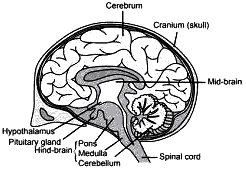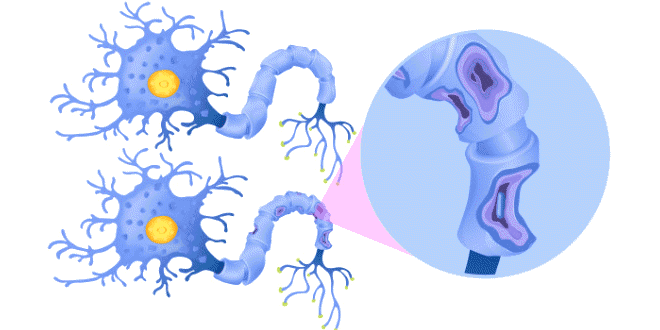Question: How does chemical coordination occur in plants? Explain with the help of three examples.
Answer: In plants, chemical coordination occurs through various phytohormones.
- Auxins secreted by growing tissues. They provide growth of plants.
- Gibberelins cause stem elongation, seed germination and flowing.
- Cytokinins present in areas of actively dividing cells like fruits, seeds. Promote cell division.
- Abscisic acid inhibits growth, respond to environmental stress. (any three)
Question: Illustrate with the help of a diagram, the effect of auxins in different parts of a plant.
Answer:

Question: (1). An old man is advised by his doctor to take less sugar in his diet. Name the disease from which the man is suffering. Mention the hormone due to imbalanced of which he is suffering from this disease. Which endocrine gland secretes this hormone?
(2). Name the endocrine gland which secretes growth hormone. What will be its effect on a person of:
(i) Deficiency of growth hormones?
(ii) Excess secretion of growth hormones?
Answer:
- The man is suffering with the disease Diabetes. Insulin is the hormone which is responsible for this disease.
Pancreas secretes this hormone. - The gland which secrete the growth hormone is pituitary gland.
(i) Deficiency of growth hormone cause Dwarfism.
(ii) Excess secretion of growth hormone cause Gigantism in a person.
Question: (1). Give the functions of cerebellum. (any two)
(2). Name the components of central nervous system.
Answer:
- (i) Cerebellum is responsible for precision of voluntary action.
(ii) It maintains the posture and balance of the body. - The components of central nervous system are: (i) Brain, (ii) Spinal cord.
Question: (1). Identify the phytohormone use by plants while performing the following function:
(i) Cell division is shoot tip.
(ii) Inhibiting growth on approach of unfavorable conditions.
(2). List in tabular form two differences between the movement in ‘touch me not’ plant and movement of shoot towards light.
Answer: (a) (i) Auxin, (ii) Abscisic acid
(b) Movement of shoot towards light (Tropism):
- It is slow response towards any stimulus.
- It is directional.
- It is growth dependent.
Movement in ‘touch me not’ plant (Nastic movement):
- It is an immediate response towards a stimulus.
- It is non-directional.
- It is growth independent. (any two)
Question: (1). How are movement of leaves of touch-me-not and growth of stem towards light different?
(2). What is chemotropism? Give one example.
(3). What is tropism?
Answer:
- The movement of leaves of touch-me-not plant is fast and non-directional while the growth of stem towards the light is slow and directional.
- Chemotropism: It is the response of the plant due to chemical stimulus.
Example: Growth of pollen tube during fertilization. - Tropism is a change in the direction of a part of a plant in response to other stimuli.
Question: List the names of hormones secreted by the following endocrine glands and mention their functions: (i) Thyroid gland (ii) Pituitary gland (iii) Adrenal gland.
Answer:
Question: Answer the following:
(1). Name the endocrine gland associated with brain.
(2). Which gland secretes digestive enzymes as well as hormone?
(3). Name the endocring gland associated with kidneys.
(4). Which endocring gland is present in males but not in females?
(5). Which hormone is responsible for change in females during puberty?
(6). Iodine is necessary for the synthesis of which hormone?
Answer:
- Pituitary gland
- Pancreas
- Adrenal gland
- Testes
- Oestrogen
- Thyroxine
Question: Give reasons:
(1). Pituitary is often termed as master endocrine gland.
(2). Pancreas helps in digestion and also regulates blood sugar level.
(3). Adrenals are known as glands of emergency.
Answer:
- Pituitary is often called as master endocrine gland because it controls and coordinates the secretion of all the other endocrine glands.
- Pancreas secretes pancreatic juice as well as a hormone called as insulin. Pancreatic juice helps in digestion whereas insulin regulates blood sugar level.
- Adrenalin is secreted directly into the blood and is carried to different parts of the body. It acts on heart. As a result, the heart beat faster in order to supply more oxygen to our muscles. The blood to the digestive system and skin is reduced due to contraction of muscles around small arteries in the organs. This diverts the blood to our skeletal muscles. The breathing rate also increases because of the contractions of the diaphragm and the rib muscles. All these responses together enable the animal body to get ready to deal with the situation.
Question: ‘Brain and spinal cord vital organs of our body’. How is our body designed to protect them?
Answer: Brain is inside a bony box contained in a fluid filled balloon which protects from shocks.
Vertebral column protects spinal cord. Or both are protected by protective layers called meninges, protective fluid (CSF → cerebrospinal fluid).
Question: (1). How tendril coil around the support?
(2). Define phototropism.
Answer:
- Tendril are sensitive to touch. When they come in contact with any support, the part of the tendril in contact with the object with the object does not grow as rapidly as the part of the tendril away from the object. This cause the tendril to coil around the support.
- Movement of plants in response to light.
Question: (a) Draw a diagram of human brain.
(b) Label on it Cerebrum, Cerebellum.
(c) What is the role of Cerebellum?
Answer: (a) and (b)

(c) Role of cerebellum: It is responsible for precision of voluntary actions and maintaining the posture and balance of the body.
Question: Name the hormones secreted by thyroid, parathyroid and pancreas.
Answer:
- Thyroid gland: It secretes thyroxine hormone.
- Parathyroid gland: It secretes calcitonin hormone.
- Pancreas: It secretes two hormones:
(i) Insulin
(ii) Glucagon
 Class Notes NCERT Solutions for CBSE Students
Class Notes NCERT Solutions for CBSE Students





